Wikipedia:Picture of the day/September 2021
|
Featured picture tools: |
These featured pictures, as scheduled below, appeared as the picture of the day (POTD) on the English Wikipedia's Main Page in September 2021. Individual sections for each day on this page can be linked to with the day number as the anchor name (e.g. [[Wikipedia:Picture of the day/September 2021#1]] for September 1).
You can add an automatically updating POTD template to your user page using {{Pic of the day}} (version with blurb) or {{POTD}} (version without blurb). For instructions on how to make custom POTD layouts, see Wikipedia:Picture of the day.Purge server cache
September 1

|
Pieris brassicae, the large white, is a species of butterfly in the family Pieridae, common in Europe, Asia and North Africa. The larva pictured here, which was found at a market in Fronton, France, is a serious pest of plants in the cabbage family, Brassicaceae. The eggs are laid in batches on the undersides of the leaves of plants rich in mustard-oil glucosides, and consumption of these substances as they chew the leaves makes the larvae distasteful; the bright colouration of the larvae signals to predators that they taste bad. Additionally, the adult butterflies emit an unpleasant smell and display warning colours. Photograph credit: Didier Descouens
Recently featured:
|
September 2

|
Liliʻuokalani (September 2, 1838 – November 11, 1917) was the only queen regnant and the last sovereign monarch of the Hawaiian Kingdom. She ascended to the throne on January 29, 1891, nine days after the death of her brother King Kalākaua. During her reign, she attempted to draft a new constitution in 1893 that would restore the power of the monarchy and the voting rights of the economically disenfranchised. Threatened by her attempts to abrogate the 1887 Bayonet Constitution, pro-American elements in Hawaii overthrew the monarchy on January 17, 1893. She was placed under house arrest, was forced to abdicate the Hawaiian throne and lived the rest of her life as a private citizen. This photograph of Liliʻuokalani was signed by the queen herself and addressed to Josephus Daniels, United States Secretary of the Navy. Photograph credit: James J. Williams; restored by Adam Cuerden
Recently featured:
|
September 3

|
Severe acute respiratory syndrome coronavirus 2 (SARS‑CoV‑2) is the virus that causes COVID-19, the respiratory illness responsible for the COVID-19 pandemic. Like other coronaviruses, SARS-CoV-2 has four structural proteins, known by the letters S (spike), E (envelope), M (membrane), and N (nucleocapsid); the N protein holds the RNA genome, and the S, E, and M proteins together create the viral envelope. This colourised transmission electron micrograph shows SARS-CoV-2 virus particles emerging from the surface of cells cultured in a laboratory. The crown-like spikes on the outer edge of the virus particles give coronaviruses their name, derived from Latin corona, 'crown'. Photograph credit: National Institute of Allergy and Infectious Diseases, Rocky Mountain Laboratories
Recently featured:
|
September 4

|
Pauline Adams (1874–1957) was an Irish-American suffragist. On 4 September 1917, she and twelve other activists were arrested for attempting to "flaunt their banners" in front of President Woodrow Wilson's reviewing stand before a Selective Service parade in Washington, D.C., and they chose prison rather than paying a 25-dollar fine. This photograph depicts Adams seated at a table, wearing prison uniform and holding a cup in her raised right hand. The image was published in the newspaper The Suffragist in 1919. Photograph credit: unknown; restored by Adam Cuerden
Recently featured:
|
September 5
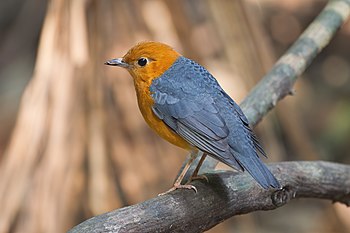
|
The orange-headed thrush (Geokichla citrina) is a species of bird in the thrush family, Turdidae. About 225 mm (9 in) in length, it is common in well-wooded areas of the Indian subcontinent and Southeast Asia, but is a shy, secretive bird, usually occurring alone or in pairs. It mainly feeds on the ground in dense undergrowth, and is most active at dawn and dusk, probing the leaf litter for insects and their larvae, spiders, other invertebrates and fruit. This male orange-headed thrush, of the subspecies G. c. innotata, was photographed in Khao Yai National Park in Nakhon Ratchasima, Thailand. Photograph credit: John Harrison
Recently featured:
|
September 6

|
Marie-Gabrielle Capet (6 September 1761 – 1 November 1818) was a French Neoclassical painter. Until the French Revolution, the Royal Academy of Art in Paris was responsible for training artists and exhibiting artworks at the Salon, but limited the number of female students to four at a time. Unable to gain a place, she moved to Paris in 1781 to become a student of Adélaïde Labille-Guiard, with whom she struck up a lifelong friendship. She specialised in painting portraits, her works including oil paintings, watercolours and miniatures. This oil-on-canvas self-portrait of Capet, dating from around 1783, is in the collection of the National Museum of Western Art in Tokyo. Painting credit: Marie-Gabrielle Capet
Recently featured:
|
September 7

|
Howell Cobb (September 7, 1815 – October 9, 1868) was an American politician and five-term member of the United States House of Representatives who served as Speaker of the House from 1849 to 1851. He also served as the 40th governor of Georgia from 1851 to 1853, and as Secretary of the Treasury under President James Buchanan from 1857 to 1860. Cobb is probably best known as one of the founders of the Confederacy, having served as president of the Provisional Congress of the Confederate States. This line engraving of Cobb was produced around 1902 by the Department of the Treasury's Bureau of Engraving and Printing (BEP) as part of a BEP presentation album of the first 42 secretaries of the treasury. Engraving credit: Bureau of Engraving and Printing; restored by Andrew Shiva
Recently featured:
|
September 8

|
Ālī Qāpū is an imperial palace in Isfahan, Iran, built in the late 16th century. The palace served as the official residence of Persian emperors of the Safavid dynasty. In 1979, UNESCO inscribed the palace and the adjoining Naqsh-e Jahan Square as a World Heritage Site due to their cultural and historical importance. This panoramic photograph of Ālī Qāpū, captured using high-dynamic-range imaging during the golden hour, consists of twenty-five frames digitally merged together. Photograph credit: Amir Pashaei
Recently featured:
|
September 9
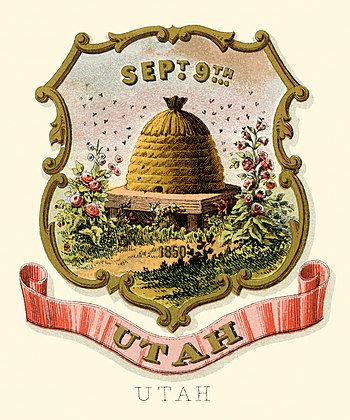
|
The Utah Territory was a U.S. territory in the Western United States that existed from its creation on September 9, 1850, to its admission to the Union on January 4, 1896 as the State of Utah. This picture shows the Utah Territory's historical coat of arms, as illustrated by American engraver Henry Mitchell in State Arms of the Union, published in 1876 by Louis Prang. The escutcheon depicts a beehive, representing the state's industrious and hard-working inhabitants, and sego lilies symbolizing peace. Illustration credit: Henry Mitchell; restored by Andrew Shiva
Recently featured:
|
September 10

|
Papilio polymnestor, the blue Mormon, is a species of swallowtail butterfly found in southern India and Sri Lanka. It is a woodland species, often seen on forest paths and near streams. The larvae feed on trees in the family Rutaceae, such as citrus. Young larvae are green with white markings and position themselves on the upper surface of leaves, relying on their cryptic colouring, which resembles bird droppings, for protection. Older larvae seek less conspicuous locations, and have a unique habit of securing their balance by weaving silk on the substratum. This adult male P. polymnestor butterfly was photographed in the Indian state of Kerala. Photograph credit: Jeevan Jose
Recently featured:
|
September 11

|
Martha Ann Honeywell (1786–1856) was an American disabled artist who produced silhouettes and paper-cutout images using only her mouth, arm stumps and toes, often in public performances. She sold cutouts such as this one as souvenirs. The text at the center of this cutout, with framed dimensions of 8+1⁄4 in × 7+5⁄8 in (21 cm × 19 cm), is the standard text of the Lord's Prayer, signed underneath with the inscription "Written without hands by Martha Honeywell". The work is now in the collection of the Metropolitan Museum of Art in New York. Cutout credit: Martha Ann Honeywell
Recently featured:
|
September 12

|
Philip Francis Thomas (12 September 1810 – 2 October 1890) was an American lawyer and politician. He served in the Maryland House of Delegates and was the 28th governor of Maryland from 1848 to 1851. In 1860, he was appointed as the 23rd United States secretary of the treasury, in President James Buchanan's administration. He held the post for only one month, resigning after he failed to obtain a loan to pay the interest on the bonded public debt. After unsuccessfully standing for election to the United States Senate in 1878, he returned to the Maryland House of Delegates and later resumed the practice of law. Engraving credit: Bureau of Engraving and Printing; restored by Andrew Shiva
Recently featured:
|
September 13

|
Total internal reflection is the optical phenomenon in which light waves are completely reflected under certain conditions when they arrive at the boundary between one medium and another. This photograph was taken from near the bottom of the shallow end of a swimming pool. The swimmer has disturbed the water surface above her, scrambling the lower half of her reflection, and distorting the reflection of the ladder. Most of the surface is still calm, giving a clear reflection of the tiled bottom of the pool. The air above the water is not visible except at the top of the frame where the angle of incidence of light waves is less than the critical angle and therefore total internal reflection has not occurred. Photograph credit: Jean-Marc Kuffer
Recently featured:
|
September 14

|
The red-backed shrike (Lanius collurio) is a carnivorous passerine bird and a member of the shrike family, Laniidae. It breeds in a range stretching from western Europe eastwards to central Russia, and it overwinters in the eastern areas of tropical and southern Africa. About 17 centimetres (7 inches) in length, it feeds on large insects, small birds, frogs, rodents and lizards. Like other shrikes, it hunts from prominent perches, and impales corpses on thorns or barbed wire as a "larder". This male red-backed shrike was photographed at Lake Kerkini in northern Greece. Photograph credit: Antonios Tsaknakis
Recently featured:
|
September 15
Subpage 1

|
The Cuban peso is the official currency of Cuba. Under the Spanish administration, the Banco Español de la Habana introduced Cuba's first issue of banknotes in 1857 in denominations of 50, 100, 300, 500 and 1,000 dollars. Beginning in 1872, fractional peso banknotes were issued in denominations of 5, 10, 20, 25 and 50 centavos, printed in strips of ten. This five-centavo banknote was issued in 1876, and now forms part of the National Numismatic Collection at the Smithsonian Institution. Banknote design credit: American Bank Note Company; photographed by Andrew Shiva
Recently featured:
|
Subpage 2

|
The Cuban peso is the official currency of Cuba. Under the Spanish administration, the Banco Español de la Habana introduced Cuba's first issue of banknotes in 1857 in denominations of 50, 100, 300, 500 and 1,000 dollars. Beginning in 1872, fractional peso banknotes were issued in denominations of 5, 10, 20, 25 and 50 centavos, printed in strips of ten. This ten-centavo banknote was issued in 1883, and now forms part of the National Numismatic Collection at the Smithsonian Institution. Banknote design credit: American Bank Note Company; photographed by Andrew Shiva
Recently featured:
|
Subpage 3
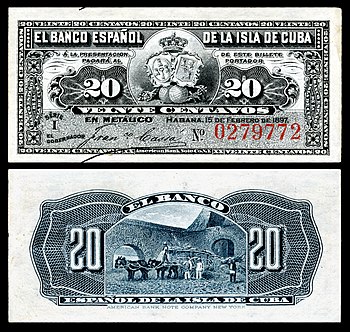
|
The Cuban peso is the official currency of Cuba. Under the Spanish administration, the Banco Español de la Habana introduced Cuba's first issue of banknotes in 1857 in denominations of 50, 100, 300, 500 and 1,000 dollars. Beginning in 1872, fractional peso banknotes were issued in denominations of 5, 10, 20, 25 and 50 centavos, printed in strips of ten. This twenty-centavo banknote was issued in 1897, by which time the bank had been renamed the Banco Español de la Isla de Cuba. The banknote now forms part of the National Numismatic Collection at the Smithsonian Institution. Banknote design credit: American Bank Note Company; photographed by Andrew Shiva
Recently featured:
|
Subpage 4

|
The Cuban peso is the official currency of Cuba. Under the Spanish administration, the Banco Español de la Habana introduced Cuba's first issue of banknotes in 1857 in denominations of 50, 100, 300, 500 and 1,000 dollars. Beginning in 1872, fractional peso banknotes were issued in denominations of 5, 10, 20, 25 and 50 centavos, printed in strips of ten. This twenty-five-centavo banknote was issued in 1872, and now forms part of the National Numismatic Collection at the Smithsonian Institution. Banknote design credit: American Bank Note Company; photographed by Andrew Shiva
Recently featured:
|
Subpage 5
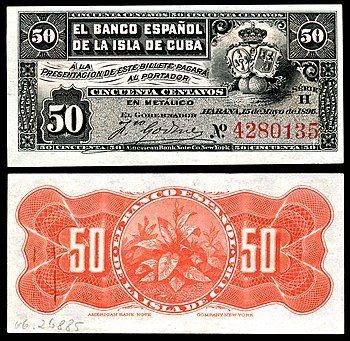
|
The Cuban peso is the official currency of Cuba. Under the Spanish administration, the Banco Español de la Habana introduced Cuba's first issue of banknotes in 1857 in denominations of 50, 100, 300, 500 and 1,000 dollars. Beginning in 1872, fractional peso banknotes were issued in denominations of 5, 10, 20, 25 and 50 centavos, printed in strips of ten. This fifty-centavo banknote was issued in 1896, by which time the bank had been renamed the Banco Español de la Isla de Cuba. The banknote now forms part of the National Numismatic Collection at the Smithsonian Institution. Banknote design credit: American Bank Note Company; photographed by Andrew Shiva
Recently featured:
|
September 16

|
Kew Gardens is a botanic garden in southwest London. Founded in 1840, its living collections include some 27,000 taxa while the herbarium houses over 8.5 million preserved plant and fungal specimens. This photograph shows the Davies Alpine House, which opened in 2006. The design of the greenhouse encourages natural airflow, the automatically operated blinds prevent overheating, and the glass is of a special type that allows maximum transmission of ultraviolet light. The structure houses a collection of alpine plants that grow above the tree line in their localities of origin. Photograph credit: Daniel Case
Recently featured:
|
September 17

|
Grand Ayatollah Mirza Mohsen Koochebaghi Tabrizi (9 January 1924 – 3 August 2011) was an Iranian Marja' (religious authority) of the Twelver Shia branch of Islam. This photograph of Tabrizi was taken in 2010, the year before his death, at his home in Tabriz, Iran. Photograph credit: Mehrdad
Recently featured:
|
September 18

|
|
The siege of Osaka was a series of battles undertaken by the Japanese Tokugawa shogunate against the Toyotomi clan, and ending in the clan's dissolution. Divided into two stages (the winter campaign and the summer campaign), and lasting from 1614 to 1615, the siege put an end to the last major armed opposition to the shogunate's establishment. This eight-metre-long (26 ft) painting, titled The Summer Battle of Osaka Castle and executed on a Japanese folding screen, illustrates Osaka Castle under siege, and was commissioned by the daimyo Kuroda Nagamasa, who took a team of painters with him to the battlefield to record the event. The painting depicts 5071 people and 21 generals, and is held in the collection of Osaka Castle. Painting credit: unknown
Recently featured:
|
September 19

|
Giacomo Meyerbeer (1791–1864) was a German opera composer. Born to a wealthy Berlin family, he began his musical career as a pianist but soon decided to devote himself to opera. Meyerbeer spent several years in Italy studying and composing, before moving to Paris, where he became a dominant figure in the world of opera. This poster advertised the premiere of Meyerbeer's opera Le pardon de Ploërmel, which opened at the Opéra-Comique in Paris on 4 April 1859. Poster credit: Henri Télory; restored by Adam Cuerden
Recently featured:
|
September 20

|
The Indian rhinoceros (Rhinoceros unicornis) is a species of rhinoceros that once ranged across the entire northern part of the Indian subcontinent. As a result of habitat destruction and climatic changes, its range was gradually reduced such that, by the 19th century, it survived only in southern Nepal, northern Uttar Pradesh, northern Bihar, northern West Bengal, and in the Brahmaputra Valley in Assam. The species's range has since shrunk further, and its habitat is surrounded by human-dominated landscapes, so that in many areas, it occurs in cultivated areas, pastures, and secondary forests. It is currently listed as a vulnerable species on the IUCN Red List. This adult male Indian rhinoceros was photographed on the banks of the Gandaki River in Nepal. Photograph credit: Charles James Sharp
Recently featured:
|
September 21

|
Asahi Breweries is a Japanese global beer, spirits, soft drinks and food business group. This photograph, taken during the blue hour with a full moon, shows the headquarters of Asahi Breweries in Sumida, Tokyo, as viewed from the wharf on the Sumida River near Azuma Bridge. The Asahi Beer Hall, topped by the Asahi Flame, designed by Philippe Starck, is visible on the right, with the Tokyo Skytree in the background on the left. Photograph credit: Basile Morin
Recently featured:
|
September 22

|
Lillian Ascough (1880–1974) was an American suffragist. She served as the Connecticut chair of the National Woman's Party (NWP) and the vice president of the Michigan branch of the NWP. She was a speaker in the Suffrage Special, an event created by the Congressional Union for Woman Suffrage in 1916, which toured the "free states" which had already allowed women's suffrage in the United States. This formal photographic portrait of Ascough was taken around 1915 and published in the magazine The Suffragist. Photograph credit: Edmonston; restored by Adam Cuerden
Recently featured:
|
September 23
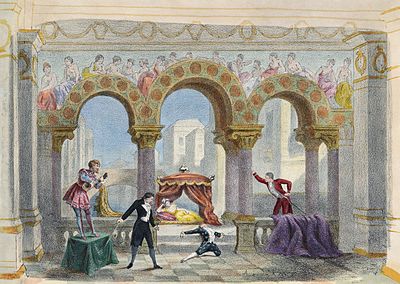
|
The Tales of Hoffmann (Les contes d'Hoffmann) is an opéra fantastique by Jacques Offenbach. The French libretto was written by Jules Barbier based on three short stories by E. T. A. Hoffmann, who is the opera's protagonist. It was Offenbach's final work; he died in October 1880, four months before the premiere at the Opéra-Comique in Paris. This illustration, probably by Pierre-Auguste Lamy, shows the third act, set in Venice, as illustrated for the first production of the opera in 1881. This act was in fact omitted from the premiere performance itself, the orchestration being incomplete at the time of the composer's death. Illustration credit: Pierre-Auguste Lamy (attributed); restored by Adam Cuerden
Recently featured:
|
September 24
|
The red-rumped parrot (Psephotus haematonotus) is a common bird native to south-eastern Australia. About 28 centimetres (11 in) long, the male's plumage is a bright emerald-green with yellow underparts, a brick-red rump and blue highlights on the upper back and wings; the female is altogether more dowdy, having dull-green wings and back, bluish-black wingtips and pale-olive underparts. These parrots are typically found in pairs or small groups in open country with access to water, including in suburban parks and gardens. These male and female red-rumped parrots were photographed in Cornwallis, New South Wales. Photograph credit: John Harrison
Recently featured:
|
September 25

|
|
Equestrian Portrait of Cornelis and Michiel Pompe van Meerdervoort with Their Tutor and Coachman, also known as Starting for the Hunt, is an oil-on-canvas painting by Aelbert Cuyp. Created around 1652–53, the painting depicts two young brothers and their retainers about to embark on a hunt. The ruined castle, likely intended to indicate the ancient lineage of those pictured, does not resemble the Pompe van Meerdervoort family home, and was originally painted in the left middleground before being repainted on the right. In the background on the left, sailing boats can be seen on the Rhine. The painting is in the collection of the Metropolitan Museum of Art in New York. Painting credit: Aelbert Cuyp
Recently featured:
|
September 26

|
Santi Giovanni e Paolo al Celio is an ancient basilica in Rome, located on the Caelian Hill. The first church was built there in 398, and a series of ancient Roman rooms with frescos were discovered under the nave during 19th-century excavations. The altar, in the background of this photograph, is built over a bath containing the remains of John and Paul, two Roman soldiers martyred under Emperor Julian in 362, and to whom the basilica is dedicated. Photograph credit: Livioandronico2013 |
September 27

|
War pigeons are homing pigeons used in military service. They have long played an important role in war, often being used as military messengers. Before the advent of radio, carrier pigeons were used on the battlefield as a means for mobile forces to communicate with stationary headquarters. A metal canister containing the message was attached to the bird's leg. This photograph, in the Swiss Federal Archives, shows Swiss Armed Forces personnel preparing a pigeon for a mission during World War I. The Swiss army made extensive use of carrier pigeons, finally disbanding its pigeon section in 1996. Photograph credit: unknown; restored by Adam Cuerden |
September 28

|
The Atari 2600, originally branded as the Atari Video Computer System, is a home video game console developed and produced by Atari. Released in September 1977, it popularized the use of microprocessor-based hardware and of games stored on swappable ROM cartridges, a format first used with the Fairchild Channel F the year before. The VCS was bundled with two joystick controllers, a conjoined pair of paddle controllers, and a game cartridge – initially Combat and later Pac-Man. Photograph credit: Evan Amos |
September 29

|
Parson's chameleon (Calumma parsonii) is a large species of chameleon, a lizard in the family Chamaeleonidae. The species is endemic to isolated pockets of humid primary forest in eastern and northern Madagascar. It is listed on CITES Appendix II, meaning that trade in this species is regulated. While it is illegal for most chameleon species from Madagascar to be exported, a limited number of Parson's chameleons can legally be exported each year from its native country. This female Parson's chameleon of the subspecies C. p. cristifer was photographed near Andasibe, Moramanga. Photograph credit: Charles James Sharp
Recently featured:
|
September 30

|
Georges Ernest Boulanger (29 April 1837 – 30 September 1891), nicknamed Général Revanche, was a French general and politician. An enormously popular public figure during the Third Republic, he won a series of elections and was feared to be powerful enough to establish himself as dictator at the zenith of his popularity in January 1889. This photograph of Boulanger was produced by the atelier of the French photographer Nadar. Photograph credit: Atelier Nadar; restored by Adam Cuerden
Recently featured:
|
Picture of the day archives and future dates


